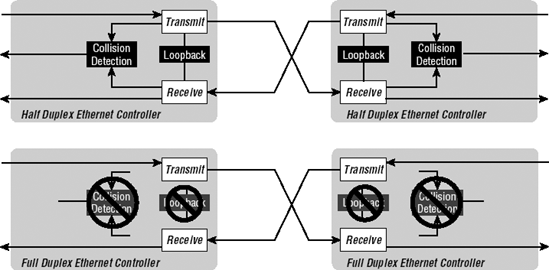7.3. Full Duplex Ethernet
In the scenario depicted in Figure 7-3, we can modify the behavior of the Ethernet MAC controller in both the switch and the attached devices to take advantage of their unique situation. We need to:
Disable the Carrier Sense function as it is normally used to defer transmissions. That is, the reception of data on the receive channel should not cause the transmitter to defer any pending transmissions. A normal (half duplex) Ethernet interface will withhold its own transmissions in order to avoid interfering with transmissions in progress under control of the carrier sense signal.
Disable the Collision Detect function, which would normally cause the transmitter to abort, jam, and reschedule its transmission if it detects a receive signal while transmitting.
Disable the looping back of transmitted data onto the receiver input, as is done on a half duplex channel.
Neither end of the link needs to defer to received traffic, nor is there any interference between transmissions and receptions, avoiding the need for collision detection, back off, and retry. In this environment, we can operate the LAN in full duplex mode; stations can both transmit and receive simultaneously, as depicted in Figure 7-4.
Figure 7.4. Half and full duplex Ethernet MAC

7.3.1. "Ethernet Is CSMA/CD"
The very term Ethernet has come to mean that class of LANs that use CSMA/CD as their MAC ...
Get The All-New Switch Book: The Complete Guide to LAN Switching Technology, Second Edition now with the O’Reilly learning platform.
O’Reilly members experience books, live events, courses curated by job role, and more from O’Reilly and nearly 200 top publishers.

